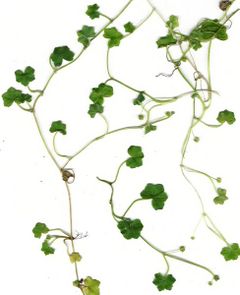Hydrocotyle
| subsp. var. | ||||||||||||||||||||||||||||||||||||||||||||||||||||||||
|---|---|---|---|---|---|---|---|---|---|---|---|---|---|---|---|---|---|---|---|---|---|---|---|---|---|---|---|---|---|---|---|---|---|---|---|---|---|---|---|---|---|---|---|---|---|---|---|---|---|---|---|---|---|---|---|---|

|
|
| ||||||||||||||||||||||||||||||||||||||||||||||||||||||
| ||||||||||||||||||||||||||||||||||||||||||||||||||||||||
| Standard Cyclopedia of Horticulture |
|---|
|
Hydrocotyle (Greek, water and cup; the plants thrive in moist places, and the roundish leaves have a cup-like depression in the middle). Umbelliferae. Water Pennywort. Slender creeping perennials of wet places, one of which is somewhat used in carpet- bedding. Herbs, with round or reniform often peltate lvs., and scale-like stipules at the base of the petioles: fls. very small, white, in umbels or umbel-like clusters opposite the lvs., sometimes 1 umbel appearing above another; calyx-teeth minute; petals entire, concave: fr. strongly compressed.—Species about 75, widely distributed around the world, several being native in the U. S. and Canada.
|
| Hydrocotyle {{{status}}} Fossil range: {{{fossil_range}}}
| ||||||||||||||||||||||||||||||||||||||||||||||||||||||||||||||||||
|---|---|---|---|---|---|---|---|---|---|---|---|---|---|---|---|---|---|---|---|---|---|---|---|---|---|---|---|---|---|---|---|---|---|---|---|---|---|---|---|---|---|---|---|---|---|---|---|---|---|---|---|---|---|---|---|---|---|---|---|---|---|---|---|---|---|---|
 Hydrocotyle bowlesioides | ||||||||||||||||||||||||||||||||||||||||||||||||||||||||||||||||||
| Plant Info | ||||||||||||||||||||||||||||||||||||||||||||||||||||||||||||||||||
| ||||||||||||||||||||||||||||||||||||||||||||||||||||||||||||||||||
| Scientific classification | ||||||||||||||||||||||||||||||||||||||||||||||||||||||||||||||||||
| ||||||||||||||||||||||||||||||||||||||||||||||||||||||||||||||||||
| [[{{{diversity_link}}}|Diversity]] | ||||||||||||||||||||||||||||||||||||||||||||||||||||||||||||||||||
| {{{diversity}}} | ||||||||||||||||||||||||||||||||||||||||||||||||||||||||||||||||||
| Binomial name | ||||||||||||||||||||||||||||||||||||||||||||||||||||||||||||||||||
| {{{binomial}}} | ||||||||||||||||||||||||||||||||||||||||||||||||||||||||||||||||||
| Trinomial name | ||||||||||||||||||||||||||||||||||||||||||||||||||||||||||||||||||
| {{{trinomial}}} | ||||||||||||||||||||||||||||||||||||||||||||||||||||||||||||||||||
| Type Species | ||||||||||||||||||||||||||||||||||||||||||||||||||||||||||||||||||
| {{{type_species}}} | ||||||||||||||||||||||||||||||||||||||||||||||||||||||||||||||||||
| Species | ||||||||||||||||||||||||||||||||||||||||||||||||||||||||||||||||||
| [[Image:{{{range_map}}}|{{{range_map_width}}}|]] | ||||||||||||||||||||||||||||||||||||||||||||||||||||||||||||||||||
| Synonyms | ||||||||||||||||||||||||||||||||||||||||||||||||||||||||||||||||||
| {{{synonyms}}} |
Hydrocotyle (Pennywort) is a genus of aquatic or semi-aquatic plants formerly classified in the family Apiaceae, now in the family Araliaceae. At least two species are now classed as invasive aliens following introductions outside of their normal range.
About 75(–100) species: tropical and temperate regions worldwide.
The leaves are generally orbicular, hence the common name.
Ecology
Occur in and near ponds, lakes, rivers, and marshes
Selected species
- Hydrocotyle americana
- Hydrocotyle bonariensis
- Hydrocotyle bowlesioides
- Hydrocotyle hirsuta
- Hydrocotyle leucocephala
- Hydrocotyle moschata
- Hydrocotyle prolifera
- Hydrocotyle pusilla
- Hydrocotyle ranunculoides
- Hydrocotyle sibthorpioides
- Hydrocotyle umbellata
- Hydrocotyle verticillata
- Hydrocotyle vulgaris